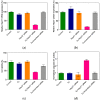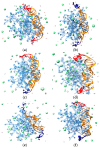Evolution from Covalent to Self-Assembled PAMAM-Based Dendrimers as Nanovectors for siRNA Delivery in Cancer by Coupled In Silico-Experimental Studies. Part I: Covalent siRNA Nanocarriers
- PMID: 31323863
- PMCID: PMC6680565
- DOI: 10.3390/pharmaceutics11070351
Evolution from Covalent to Self-Assembled PAMAM-Based Dendrimers as Nanovectors for siRNA Delivery in Cancer by Coupled In Silico-Experimental Studies. Part I: Covalent siRNA Nanocarriers
Abstract
Small interfering RNAs (siRNAs) represent a new approach towards the inhibition of gene expression; as such, they have rapidly emerged as promising therapeutics for a plethora of important human pathologies including cancer, cardiovascular diseases, and other disorders of a genetic etiology. However, the clinical translation of RNA interference (RNAi) requires safe and efficient vectors for siRNA delivery into cells. Dendrimers are attractive nanovectors to serve this purpose, as they present a unique, well-defined architecture and exhibit cooperative and multivalent effects at the nanoscale. This short review presents a brief introduction to RNAi-based therapeutics, the advantages offered by dendrimers as siRNA nanocarriers, and the remarkable results we achieved with bio-inspired, structurally flexible covalent dendrimers. In the companion paper, we next report our recent efforts in designing, characterizing and testing a series of self-assembled amphiphilic dendrimers and their related structural alterations to achieve unprecedented efficient siRNA delivery both in vitro and in vivo.
Keywords: PAMAM dendrimers; RNAi therapeutics; covalent dendrimers; gene silencing; nanovectors; siRNA delivery.
Conflict of interest statement
The authors declare no conflict of interest.
Figures



















Similar articles
-
Evolution from Covalent to Self-Assembled PAMAM-Based Dendrimers as Nanovectors for siRNA Delivery in Cancer by Coupled in Silico-Experimental Studies. Part II: Self-Assembled siRNA Nanocarriers.Pharmaceutics. 2019 Jul 10;11(7):324. doi: 10.3390/pharmaceutics11070324. Pharmaceutics. 2019. PMID: 31295912 Free PMC article. Review.
-
Structurally flexible triethanolamine-core poly(amidoamine) dendrimers as effective nanovectors to deliver RNAi-based therapeutics.Biotechnol Adv. 2014 Jul-Aug;32(4):844-52. doi: 10.1016/j.biotechadv.2013.08.001. Epub 2013 Aug 9. Biotechnol Adv. 2014. PMID: 23938269 Review.
-
Dendrimer Nanovectors for SiRNA Delivery.Methods Mol Biol. 2016;1364:127-42. doi: 10.1007/978-1-4939-3112-5_11. Methods Mol Biol. 2016. PMID: 26472447
-
PAMAM dendrimers for siRNA delivery: computational and experimental insights.Chemistry. 2010 Jul 12;16(26):7781-95. doi: 10.1002/chem.200903258. Chemistry. 2010. PMID: 20496352
-
Self-assembly of amphiphilic phospholipid peptide dendrimer-based nanovectors for effective delivery of siRNA therapeutics in prostate cancer therapy.J Control Release. 2020 Jun 10;322:416-425. doi: 10.1016/j.jconrel.2020.04.003. Epub 2020 Apr 2. J Control Release. 2020. PMID: 32247806
Cited by
-
Emerging Nano-Based Strategies Against Drug Resistance in Tumor Chemotherapy.Front Bioeng Biotechnol. 2021 Dec 7;9:798882. doi: 10.3389/fbioe.2021.798882. eCollection 2021. Front Bioeng Biotechnol. 2021. PMID: 34950650 Free PMC article. Review.
-
Self-assembling ferritin-dendrimer nanoparticles for targeted delivery of nucleic acids to myeloid leukemia cells.J Nanobiotechnology. 2021 Jun 9;19(1):172. doi: 10.1186/s12951-021-00921-5. J Nanobiotechnology. 2021. PMID: 34107976 Free PMC article.
-
Unchain My Blood: Lessons Learned from Self-Assembled Dendrimers as Nanoscale Heparin Binders.Biomolecules. 2019 Aug 20;9(8):385. doi: 10.3390/biom9080385. Biomolecules. 2019. PMID: 31434309 Free PMC article. Review.
-
Current Landscape and Future Directions in Cancer Immunotherapy: Therapies, Trials, and Challenges.Cancers (Basel). 2025 Feb 27;17(5):821. doi: 10.3390/cancers17050821. Cancers (Basel). 2025. PMID: 40075668 Free PMC article. Review.
-
Recent Progress and Advances of Multi-Stimuli-Responsive Dendrimers in Drug Delivery for Cancer Treatment.Pharmaceutics. 2019 Nov 8;11(11):591. doi: 10.3390/pharmaceutics11110591. Pharmaceutics. 2019. PMID: 31717376 Free PMC article. Review.
References
Publication types
Grants and funding
LinkOut - more resources
Full Text Sources
Other Literature Sources

